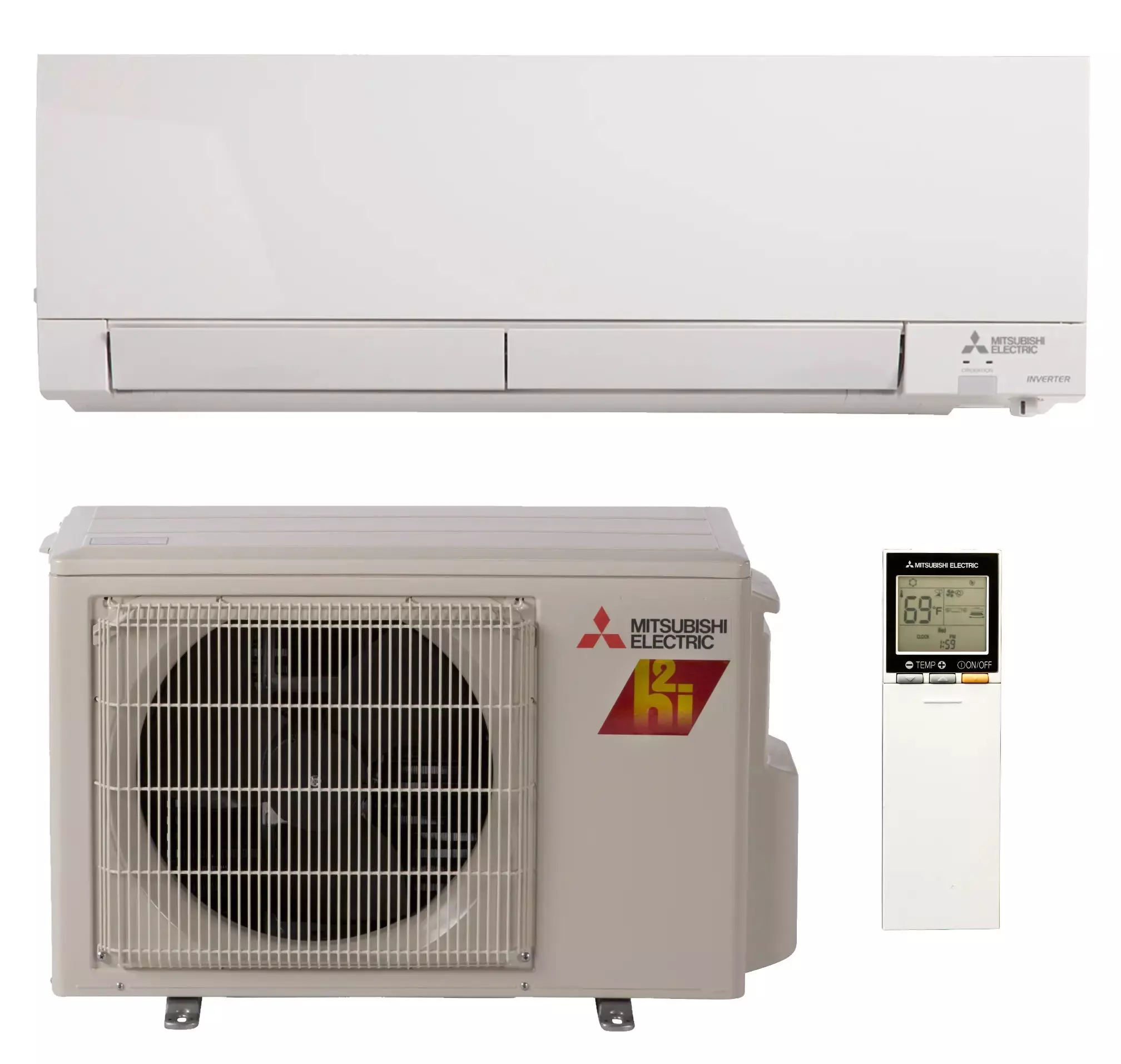Mitsubishi mini split systems have become increasingly popular among homeowners looking for efficient and effective cooling solutions for specific zones or individual areas of their homes. With separate indoor units, known as air handlers, ductless mini split units offer superior temperature control compared to traditional systems. Whether you opt for a single- or multi-zone system, each room can have its own temperature setting, eliminating the need for constant AC control battles. Additionally, ductless systems offer the flexibility of not requiring any ductwork, which saves money, reduces installation time, and provides more design freedom for your home.
 Image: Mitsubishi logo
Image: Mitsubishi logo
One of the main reasons for the increasing popularity of Mitsubishi ductless heating and cooling systems is their ability to save on energy costs. By allowing you to set different temperatures for different areas of your home and utilizing super-efficient heat pump technology, Mitsubishi mini split systems contribute to significant energy savings.
In this comprehensive guide, we will explore what a ductless air conditioner unit is and how you can make the most of its features. By the end, you'll be equipped with the knowledge needed to choose the right Mitsubishi heat pump for your home.
Mitsubishi Mini Split System Components
A mini split system comprises four main components:
Condensing Unit
The condensing unit, located outside the home, houses the condenser coil responsible for cooling the refrigerant liquid. It pumps the cooled refrigerant through the refrigerant lines that connect to the air handling unit(s) inside the home.
Refrigerant Lines
Refrigerant lines, also known as line sets, connect the exterior component of the ductless unit to the indoor unit(s). These small tubes contain cooling refrigerant and require a hole to be bored through the wall to connect both the external and internal units.
Wall Monitor or Remote Control
Both the wall monitor and remote control are used to control the entire Mitsubishi mini split air conditioning system. With these components, you can easily change modes, adjust the temperature, and configure other settings.
Indoor Unit
There are various ways to install the indoor unit in your home. While wall mounting is the most popular option, you can also opt for floor mounts or ceiling installations using cassettes or concealed ducted air handlers. Choose a location and height that ensures optimal air circulation and easy access.
Mitsubishi Mini Split Benefits
There are numerous benefits of Mitsubishi mini split air conditioners and heat pumps for homeowners:
-
No Ducts: Unlike traditional AC systems that require ductwork, ductless mini splits eliminate the need for retrofitting your home and the potential spread of allergens and other particles through dirty ducts. Additionally, ducts in traditional systems often suffer from cracks, disconnections, and leaks, leading to reduced efficiency. By not having any ducts in your AC unit, you can ensure top performance.
-
Quiet: Mini split systems are generally very quiet, with the compressor unit installed outside the house. While there may be some noise from the indoor unit(s) fan, it is negligible.
-
No Windows Required: Unlike most room AC systems that require window installations for venting, Mitsubishi mini split systems can be used without windows.
-
Zone Cooling: One of the notable features of ductless mini splits is zone cooling, which allows you to cool individual rooms separately. For example, you can choose to keep your bedroom's AC off until you're ready to go to bed. This contrasts with central air conditioning systems that cool the entire home at once. By utilizing zone cooling, you can save on energy costs by not cooling rooms that are not in use.
Mitsubishi Single vs. Multi-Zone Ductless Units
There are two types of Mitsubishi mini split air conditioning systems: single zone and multi-zone.
Single Zone: Single zone ductless systems consist of one indoor and one outdoor unit. They are often used in rooms without existing ductwork for central air conditioning. When purchasing a single zone unit, pay attention to its power output and ensure it is sufficient to cover the square footage of the intended zone. For example, the Mitsubishi MZ-FH09NAH is an efficient single zone ductless unit with 9,000 BTUs, suitable for covering between 350 and 400 square feet.
Multi-Zone: Multi-zone Mitsubishi mini splits work similarly to single zone units but can cool multiple rooms in your home. Each indoor unit is connected to a single outdoor unit through refrigerant lines, eliminating the need for a separate condenser for each indoor unit. Generally, you can have up to four zones in your home. However, Mitsubishi multi-zone mini split units such as the Mitsubishi MXZ-5C42NA2 can cover up to five zones. If installing a central air conditioning unit is not feasible, a multi-zone Mitsubishi mini split system is a great alternative.
Power: Single zone units have a specific number of BTUs assigned to them. When making a purchase, ensure that the indoor unit's BTU rating is sufficient to cover the square footage of your room. For multi-zone Mitsubishi mini split systems, both the indoor and outdoor units have BTU ratings. This means you need to consider the rating for each indoor unit to ensure it can adequately cool the intended space.
Energy Efficiency: The efficiency of a mini split system is measured using the Seasonal Energy Efficiency Ratio (SEER). Higher SEER ratings indicate greater energy efficiency. The current federal minimum SEER requirement is 13 SEER, although it may be higher depending on your location in the U.S. Each model provides an estimate of the annual operating cost, allowing you to compare different models for the best deal. Energy-star rated models are highly efficient and contribute significantly to energy savings, potentially reducing energy costs by approximately 30%.
 Image: MITSUBISHI Mini Split
Image: MITSUBISHI Mini Split
Compressor Types: Rotary vs. Inverter: There are two types of compressors: rotary and inverter compressors. Inverter compressors only use the necessary amount of power to reach the desired temperature setting and idle when more power is not required. On the other hand, rotary compressors turn on and off while attempting to maintain the set temperature, consuming more energy. Most current ductless mini splits, such as the Mitsubishi Ductless Mini Split MXZ Series Heat Pump and Air Conditioner Condenser, use inverter compressors due to their energy efficiency.
Additional Modes: Mini splits may come with various modes designed to keep you comfortable throughout the year. These modes differ depending on the model and may include:
-
Washable Air Filter: Ensure that your ductless air conditioning unit has an easily removable air filter for washing. It's also beneficial to choose a unit with a replaceable air filter to save on replacement costs.
-
Adjustable Airflow: Different models offer different methods for adjusting the airflow. Some units come with a remote control that allows you to customize the airflow, while others require manual adjustment of louvers. Automatic louvers that swing up and down to direct airflow are another feature found in some models. For example, the Mitsubishi MZ-GL09NA comes with a remote control, while the Mitsubishi MZ-FH09NAH has automatic air handlers.
-
Programmable Timer: Look for a Mitsubishi mini split air conditioner that allows you to schedule on/off times up to 24 hours in advance. This feature can be particularly useful when you arrive home after a long and tiring day.
-
Automatic Restart: Ductless air conditioning units have the advantage of automatically restarting once power is restored after a power failure, preventing circuit breaker damage.
If you're interested in purchasing Mitsubishi ductless mini split ACs at wholesale prices, you can find more options here.
Mitsubishi Mini Split Frequently Asked Questions
How much is a Mitsubishi mini split?
The cost of a Mitsubishi mini split can range from approximately $1,100 for basic single-zone split systems to over $10,000 for a five-zone ceiling cassette heat pump. Installation costs typically average around $500, but they can exceed $2,000 for multiple indoor units or complex setups.
Is Mitsubishi the best mini split?
Mitsubishi Electric pioneered the first mini split air conditioning system in 1954 and has been a leading brand in the HVAC category since. One of their significant innovations is Hyper-Heating Inverter technology, which extends the working temperature range of their heat pumps down to -13 degrees.
How much square footage does a mini split cover?
Mini splits come in capacities ranging from 6,000 to 24,000 BTUs (0.5 to two tons). The chart below provides an approximate guide for the square footage covered by each capacity. To determine the exact requirements for your space, consult a professional installer.
- 150 to 250 sq. ft. = 6,000 BTUs
- 250 to 300 sq. ft. = 7,000 BTUs
- 300 to 350 sq. ft. = 8,000 BTUs
- 350 to 400 sq. ft. = 9,000 BTUs
- 400 to 450 sq. ft. = 10,000 BTUs
- 450 to 550 sq. ft. = 12,000 BTUs
- 550 to 700 sq. ft. = 14,000 BTUs
- 700 to 1,000 sq. ft. = 18,000 BTUs
- 1,000 to 1,200 sq. ft. = 21,000 BTUs
- 1,200 to 1,400 sq. ft. = 23,000 BTUs
- 1,500 sq. ft. = 24,000 BTUs
Reference: Department of Energy. CAC Brochure. Informational Brochure. PDF. Accessed 16 July 2020. Link

















